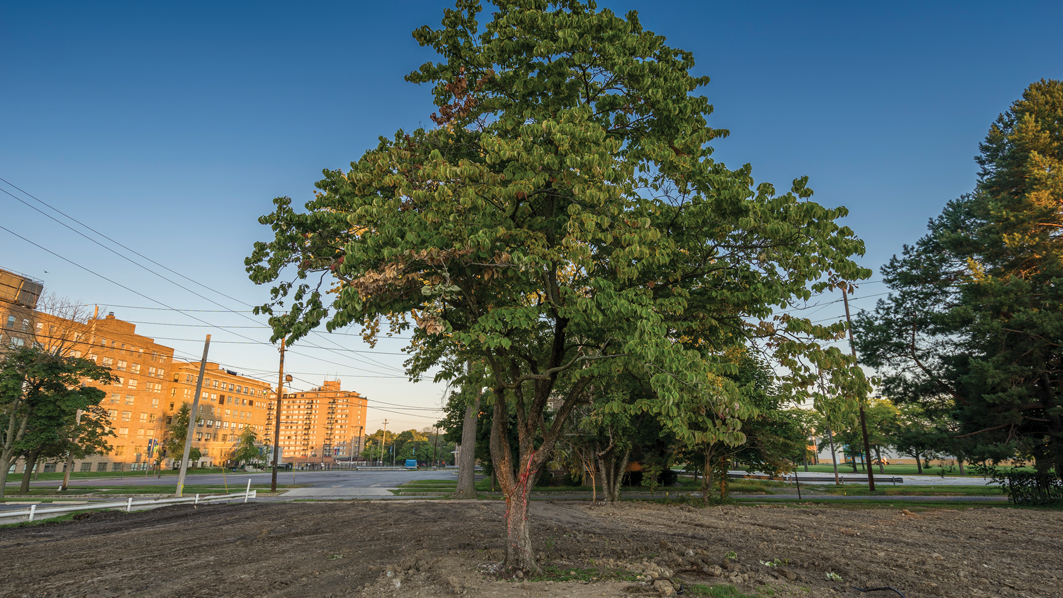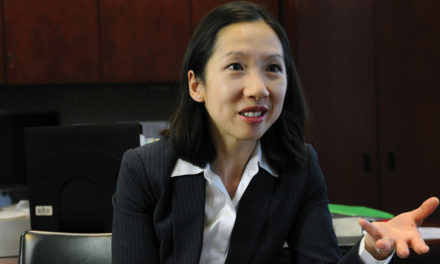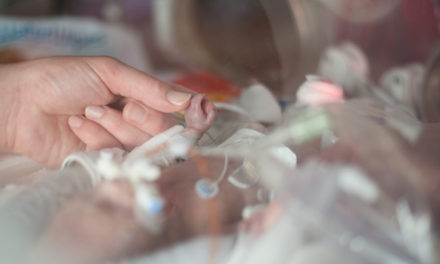Take a drive through Toledo, Ohio, a few minutes past downtown to one of the city’s grittier sec- tions, a tangle of streets marked by consecutive numbers and surnames of Founding Fathers. This neighborhood is home to soup kitchens and homeless shelters, a place where pimps and pros- titutes own the night and down-on-their-luck residents seek the substances of escapism.
Turn down a brick-paved street bordered by a jumble of medical buildings, and you’ll see it: An empty dirt lot once known as the Center for Choice.
You’d think it would be bigger, considering that 50,000 babies lost their lives here over the 30 years the abortion center operated. It closed in 2013, under fire from city officials for failing health inspections and operating without a transfer agreement with local hospitals. But according to more than one of the neighbor- hood residents who sometimes made their bed for the night under the brick smoke- stack of the ancient building next door or on the front porch of the derelict Victorian across the street, the place was busy day and night. And sometimes, even when no one was around, disembodied cries could be heard coming from the grounds.
Back when the Center still stood here, protestors would stand on the brick pavers of 22nd Street, outside the main entrance. So the owners of the facility sealed it off and had women walk past a dogwood tree through the back door to keep them from coming in contact with people who might persuade them to choose life. After their procedures, the women would leave through a side door that emptied into an alley.
All that remains now is the dogwood tree, its foliage a riot of crimson on this Indian summer October evening. According to legend, the cross on which Jesus was crucified was hewn from dogwood—and that’s doubtless why Denise Emerine, director of the Greater Toledo House of Prayer, went to no small amount of trouble to make sure the tree survived the Center’s demolition last August.
Though half a dozen pro-life groups in the Toledo area have put their stamp on the transformation of the grounds, it is Emerine—a petite 57-year-old dynamo with the kind of radical faith even other believers sometimes find crazy—who is the driving force behind the purchase of the property and the plans to turn it into a memorial to the preborn: Hope Park.
Neither word in that name is an accident. Just a few days ago, Emerine tells Citizen, a woman approached her and others on the empty lot, asking if there was a park nearby. The woman explained she’d had an abortion there years before, and that God had impressed upon her to come back to the site “because there’s a park, and He’s going to heal me.”
“That,” Emerine says with a misty-eyed smile, “is exactly what this place is going to be.”
A History of Prayer
The Center for Choice was one of two abortion facilities in Toledo—and by far the largest. Opened in 1983, it proceeded to document 50,000 abortions over the next 30 years, according to Ohio Right to Life.
Michelle McCauley, former executive director of The Pregnancy Center and currently its abortion recovery administrator, started her job in 1993—and immediately began praying for an end to abortion in the city.
“That’s been a longstanding prayer for the center and me personally because of the devastation I walked through,” she tells Citizen, “believing the lie of ‘abortion is good,’ having two and then going into a place of healing and having God put in my heart a desire to raise awareness for what abortion recovery looks like.”
In 2000, Emerine and a handful of other intercessors founded the Greater Toledo House of Prayer. And the city’s abortion facilities were high on their list of priorities.
“We had a map of Toledo and marked the abortion clinics and the Planned Parenthood building,” Emerine says. “Even little kids were praying by going up to the map, putting their fingers on it and asking God to close the clinics and rescue the babies.”
In 2004, a Catholic group called Helpers of God’s Precious Infants held three vigils a week, and also began weekly prayer and sidewalk counseling sessions. When 40 Days for Life got off the ground in 2007, the group helped bring it to Toledo.
And four years ago, the combined weight of all those prayers began to tip the bowls of Heaven.
“In March 2013, we held a joint news conference with Ohio Right to Life and called out the fact that the University of Toledo Medical Center was in cahoots with the abortion clinic to do a transfer agreement. We said a publicly funded university shouldn’t do that,” explains Ed Sitter, executive director of the Foundation For Life. “That uncovered the fact that the Center for Choice had been without a transfer agreement for the last three years.”
Under an Ohio law passed in 1999, abortion facilities must have permission from local hospitals for women to be transported there when complications arise.
The University of Toledo was negotiating a transfer agreement with the Center for Choice at the time, and had an existing agreement with the city’s other abortion facility, the Capital Care Network (CCN). But on April 2, hours after state Sen. Randy Gardner discussed the situation with UT President Lloyd Jacobs, the university announced it wasn’t going to renew the deal with CCN when it expired at the end of July—and it was terminating negotiations with the Center for Choice immediately.
A week later, the Ohio Department of Health dropped in at the Center for a surprise inspection, and cited it for a dozen health violations—including a lack of infection-control standards, as well as rusty and moldy equipment. The state recommended closing the facility, as well as fining its owner $25,000.
At about that time, Emerine had a vision as she was praying over the city: The former Center for Choice, turned into a memorial park for the victims of abortion—the nation’s second, and the only one in the Great Lakes region.
“I saw the park setting. I saw the memorial, and three pillars that had ‘Faith,’ ‘Hope’ and ‘Love’ written on them,” she recalls.
“I saw it being a place where people could come for healing through fall, spring, summer—I saw the changes of the seasons. It was kind of a two-fold thing, but I knew God was saying people would come in seasons of change, and in being there, they would witness the season of change that man could not make in his ability. And I knew He was saying on a deeper level this is a memorial to the unborn—that’s the focal point. But it’s also a place of restoration, because He’s going to restore families and people.”
She also distinctly heard the words of Isaiah 61:
The Spirit of the Sovereign Lord is upon me, because the Lord has anointed me to proclaim good news to the poor. He has sent me to bind up the brokenhearted, to proclaim freedom for the captives and release from darkness for the prisoners, to proclaim the year of the Lord’s favor and the day of vengeance of our God, to comfort all who mourn, and provide for those who grieve in Zion—to bestow on them a crown of beauty instead of ashes, the oil of joy instead of mourning, and a garment of praise instead of a spirit of despair.
She told a friend what she’d seen, and mentioned in passing that if the property ever came up for sale, she wanted to buy it.
Two months later, it did.
The Acquisition
By June 2014, the woman who owned the Center for Choice was feeling the heat. Facing a stiff fine from the state and closed doors with local hospitals, she found herself increasingly strapped for cash. So “she went on TV and began to appeal to the city and to pro-choice activists to get funding and picket the hospitals,” Emerine says.
But no one did. The intercessors kicked their prayers into an even higher gear, appealing to God to keep the Center closed.
“One particular day, I was praying and really felt in my spirit that He said, ‘Go over to the land,’ ” Emerine recalls. “So I did, and when I raised my hands it felt like the city was going to get it.”
The owner was forced to put the Center up for sale. That’s when Emerine and a group of local investors—including the Diocese of Toledo and most of the local pro-life groups—stepped forward. Though the property was appraised at just over $200,000, they wound up winning it at an auction for exactly $61,000.
“God really orchestrated it—He was the one who did this, backing up the reference to Isaiah 61!” says Emerine. “It was so exciting, but there was a deep reverence to it, too.”
The investors, including Emerine, received the keys and the deed to the Center for Choice on Oct. 7, 2014—the night of the Foundation for Life’s annual fundraising dinner.
It was a night of celebration for all the pro-life groups that had prayed to see the Center closed. But it was just the beginning of the work on what was to become Hope Park.
Under local ordinances, owners of commercial buildings who don’t plan to keep them open for business must tear them down. But the new owners of the Center for Choice couldn’t simply bulldoze the place and rip out the foundations the day after receiving the deed.
There was asbestos in the building, which eventually cost $17,000 to be removed safely. There was a gas meter that took a long time to shut down and clear out. There were pipes that had to be removed. And through it all, there were homeless people breaking in, who stripped out the prep work that had been done—raising costs and setting back the timeline. The investors boarded up the building, but the homeless tore off the boards and broke the windows. All those issues took about 15 months to resolve.
So it wasn’t until last May that Emerine and some of her most trusted friends were finally able to clean out the facility and prepare it for pre-demolition city inspection. To say they found a mess would be an understatement.
“Each of the patient rooms had been taken over by individual homeless men and women,” says Emerine. “The rooms were filled with clothes, trash, mattresses and blankets. The empty bottles were filled with urine, some had drug paraphernalia. They had defecated in all the toilets, sinks, and in the hallways, shower stalls—it was everywhere. And the water had been shut off because of freezing pipes. It was really bad!”
But that wasn’t actually the worst of it.
That would be found in the basement.
Somber Relic
It was a small vertical mini-freezer, with a typewritten note taped to the lid giving instructions on how to handle biohazardous waste. Inside were what appeared to be fetal remains. Some of the plastic pouches containing them had spilled.
And throughout the place—above the stench of fecal matter—was an indescribable, horrific odor.
“It was a death smell,” Emerine says with a shudder. “Like nothing I had ever smelled before. Everyone who came inside talked about it.”
The freezer was hauled out of the basement on May 14. It’s currently being kept in a private storage facility, to be encased in a funeral vault and buried on the grounds of Hope Park in the future—the first abortion victims to be memorialized there.
But somehow, even months afterward, the smell remained, hovering over the grounds like a spirit, even as the last roadblocks to the Center’s destruction continued to fall.
“It’s hard to describe. It was something uniquely different, and not in a good way,” says Bob Klumm, a partner at Klumm Brothers Demolition and Excavation. “We tear down buildings every day of the week. This one had an odd aura to it. Just a damp foulness—something not good.
“The smell of evil, I guess.”
Klumm’s team was on standby for more than six months, waiting for the green light to tear the Center down, which finally came on Aug. 26. Klumm and his crew not only razed the building to the ground, but had the debris cleared out within a matter of hours.
“Today’s project: Demolition of the former Center for Choice, Toledo. 50,000 unborn children killed here,” the company posted on its Facebook page that day, along with photos. “Glad to be part of wiping this evil facility from the face of the earth.”
But still the smell lingered. Until Aug. 29, when Emerine and another intercessor from the Greater Toledo House of Prayer went down to the site to pray over it as they have every Monday since May. But this time, they brought along some frankincense and myrrh to burn.
“We prayed Isaiah 61. We thanked God for what He was doing and purging the death sentence on that land, and giving it the fragrance of God—that it would be appealing for people to come to,” Emerine recalls. “We put the myrrh crystals on first, and the fragrance started to go up. When we put the frankincense crystals on, it really started to go.”
At first, the smoke moved lazily upward. But when they started playing worship music, “all of a sudden the wind kicked up and brought the smoke of the incense straight up the tree. Then it went down into the foundation, all the way back and then back up the tree.”
For two hours, Emerine and her friend watched the smoke move in this strange washboard pattern—down into the foundations, back up the dogwood tree, over and over—until the incense burned out.
When it stopped, the stench of death had disappeared.
A Night of Dedication
On this unusually perfect October evening, Emerine and representatives of the other pro-life groups behind Hope Park are gathering on the grounds with a band for a night of worship, prayer and declaration. It’s been two years to the day since they received the deed—and this evening has been set apart to celebrate what God has done, with an eye toward what He’s yet to accomplish.
Renderings of the memorial park are projected onto a large screen behind the worship band. The estimated cost to complete it: $610,000.
But for many of the few dozen people present, the healing has already begun.
Twelve years ago, Shalimar Gilbert, 29, had an abortion here. In 2013, she started receiving therapy—and actually had a few of her sessions in the building before it was torn down.
“It was emotional and traumatizing—raw and vulnerable and crazy,” she says. “There were butterflies hanging from the ceiling in the room where they did the actual surgery, and as soon as I saw them, my body went into shock.” But being here now means “there’s hope for other women who’ve had that experience. God uses His way for each person. I’m hopeful for thousands of women to come and be healed and find freedom from the guilt and shame that comes as soon as you leave the office.”
Sometime in the same year Gilbert was born, Sue Hohenbrink, 55, visited the Center for Choice. Back then, it was a brand-new facility and Hohenbrink was 24, scared to death and dealing with the results of a one-night stand.
Tonight, she hovers on the perimeters of the property, in the grass amid a collection of dandelions and used Marlboro cigarette butts, fingering a figurine of an angel holding a blonde baby. She isn’t quite ready to fully step onto the site—not yet.
She remembers running up the steps of the Center all those years ago—and then walking back down them much more slowly a few hours later, “with a big hole in my heart.” And for the next three decades, she didn’t speak about what happened.
“Someone gave me this figurine today, not even knowing I would be here,” she tells Citizen. “I always envisioned a blonde child. This is the only place on earth my baby ever existed.
“I’m at the point in my journey to find forgiveness, and this brings closure to it,” she adds. “I’m finally able to express the sin and the sorrow. But tonight, I’d rather express tears for other reasons—thankfulness that it can never happen here again.”
Over the course of two hours, the alternating sounds of worship and prayer rise under darkening skies, carried on a gentle breeze over the neighborhood, over the derelict, the degenerate and the broken—a sound of hope.
And under the dogwood tree, children dance.
For More Information:
To learn more about Hope Park, or to make a secure donation toward its completion, visit hopepark.org/donate/#new-page.http://hopepark.org/donate/#new-page
Originally published in the January 2017 issue of Citizen magazine.






